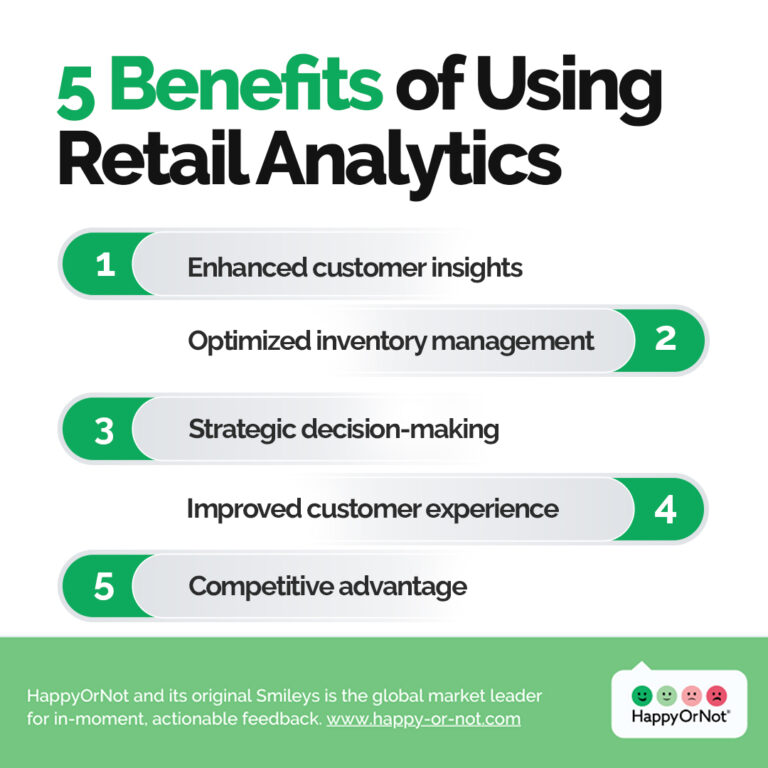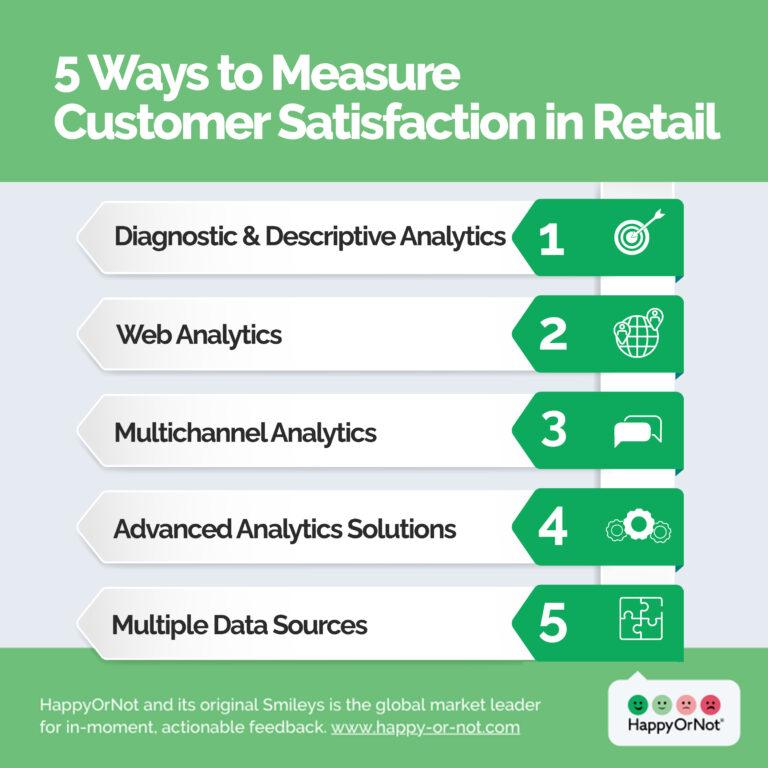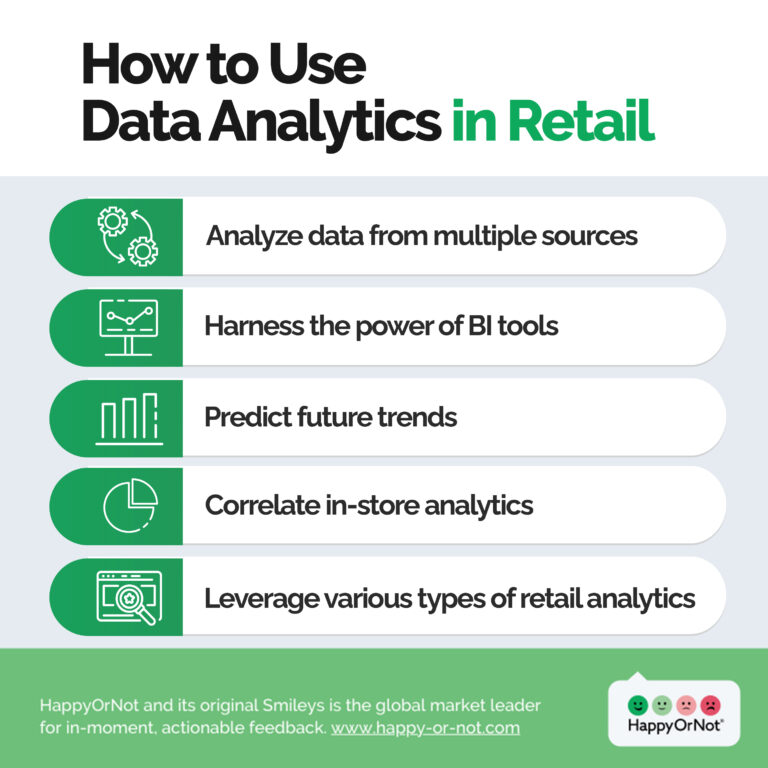How to use business analytics in retail to improve store performance
Business analytics in retail are one of the most powerful tools companies can use to increase customer satisfaction and drive long-term growth. But even though most brands know the importance of collecting data, many are still wondering how exactly they can apply analytics for retail industry to leverage all of its benefits.
In this article, we’ll give you an in-depth look into how business analytics for retail can be used for maximum impact and results that keep giving.

5 Benefits of using retail analytics
Incorporating retail data analytics into business operations opens doors to improved shopper satisfaction, efficient inventory analytics and management, and strategic decision-making.
As retailers analyze customer behavior and satisfaction, sales data, and historical trends, they optimize their operations and gain valuable insights that translate into an enhanced customer experience and sustained growth.
- Enhanced customer insights for effective marketing campaigns
Retail data analytics harnesses the power of shopper data and consumer behavior analysis, allowing retailers to tailor marketing strategies that resonate with their audience.
By understanding customer preferences and predicting future trends through predictive analytics, businesses can launch targeted marketing that drives sales and customer loyalty.
- Optimized inventory management and efficient demand forecasting
Inventory analytics empowers retail businesses with a data-driven approach to managing stock levels.
Retailers can accurately forecast customer demand by analyzing sales data and historical trends. This insight ensures that inventory levels are balanced, reducing the risk of stockouts and overstock situations.
- Strategic decision-making with comprehensive retail analytics solutions
Retailers benefit from various descriptive, diagnostic, and prescriptive analytics. These tools offer valuable insights into past and present performance, enabling businesses to make informed decisions about pricing, product assortment, and business processes.
Combined with understanding customer experience and why customers are happy with it, such strategic decision-making contributes to a competitive edge and better retail sales outcomes.
- Improved customer experience through personalized approaches
Customer retail analytics delve into customer behavior and experiences, guiding the development of effective customer loyalty programs and personalized marketing initiatives.
By analyzing customer data and satisfaction scores, businesses can improve shopper satisfaction, strengthen customer loyalty, and drive repeat purchases, both online and in-store.
- Unveiling future trends and gaining a competitive advantage
Retail predictive analytics unveils future sales trends and market dynamics, giving retailers an edge in a competitive landscape. Historical sales data and correlation with in-store customer analytics help identify emerging trends and customer preferences.
With this knowledge, businesses can strategically position themselves and forecast demand accurately, ensuring they stay ahead of the curve.

How can a retail business measure customer satisfaction?
Measuring and enhancing shopper satisfaction becomes an achievable goal that drives business success. A retail business can better understand customer satisfaction by integrating these strategies and analytics tools.
-
Implement diagnostic and descriptive analytics for sales forecasting
Descriptive analytics provide a snapshot of historical shopper data, while diagnostic analytics dive into the reasons behind specific outcomes. Combining these approaches allows you to analyze sales forecasting and customer feedback to uncover insights into shopper satisfaction.
-
Utilize web analytics for deeper customer insights
Web data analytics offer a valuable avenue for understanding customer behavior and preferences. Using web analytics for traffic and user interactions, you can gain data points highlighting areas of interest and engagement on your online store.
-
Leverage multichannel analytics for a holistic view
In today’s multichannel retail landscape, customers interact with your business through various touchpoints. Multichannel retail analytics allow you to gather data from different sources, including your retail store, online store, and social media platforms.
-
Harness the power of advanced analytics solutions
Embracing advanced data analytics tools can provide deeper insights into shopper satisfaction. These solutions go beyond fundamental analysis and employ predictive analytics models to anticipate future trends. By predicting customer preferences and behaviors, you can make informed decisions that enhance shopper experiences and drive satisfaction.
-
Combine data from multiple sources for comprehensive insights
Combining data from different channels and sources can create a holistic view of customer interactions and experiences. This comprehensive approach allows you to identify key metrics influencing shopper satisfaction and tailor your strategies accordingly.

How to use data analytics in retail
Incorporating data analytics into your retail operations is a strategic approach that can revolutionize your business. By embracing various retail analytics types, harnessing BI tools, and correlating in-store data, you can anticipate future trends, analyze data effectively, and optimize your offerings to meet customer demands.
-
Analyze data from multiple sources for comprehensive insights
Retail data is generated from various sources, including online stores, in-store interactions, and customer feedback. Analyzing data from multiple sources provides a holistic understanding of your customers and their preferences.
Combining insights from different channels can create a more accurate and well-rounded view of your customer base, leading to better decision-making and improved shopper experiences.
-
Harness the power of business intelligence tools
BI tools are essential for translating raw data into actionable insights. They enable you to gather, analyze, and visualize data from various sources, helping you identify trends and patterns that inform your decision-making process.
With the right BI tools, you can make sense of complex data sets and drive strategic improvements in your retail operations.
-
Predict future trends for strategic planning
Data analytics empowers retailers to anticipate future trends and anticipate customer preferences. By using statistical models and analyzing historical data, you can identify emerging patterns and make data-driven predictions.
This proactive approach allows you to align your inventory analytics, marketing campaigns, and overall strategy with predicted trends.
-
Correlate in-store analytics for enhanced customer experiences
Correlating in-store customer analytics with customer data allows you to comprehensively view customer behavior. By analyzing foot traffic, dwell times, and purchasing patterns, as well as customer satisfaction in your physical retail store, you can identify which merchandise attributes are most appealing to customers.
This knowledge enables you to optimize store layouts and product placements for a more engaging shopping experience.
-
Leverage various types of retail analytics
In retail, data analytics is a powerful tool for understanding customer behavior and optimizing business strategies. Different types of retail analytics, including descriptive and diagnostic analytics, allow you to delve into historical data and uncover insights into past performance.
By utilizing these techniques, you can make informed decisions that drive business growth.
Conclusion
Understanding the intricacies of merchandise attribute analytics and correlating in-store data and customer preferences allows retailers to create engaging shopping experiences that resonate with their audience. This, in turn, enhances existing customer relationships and cultivates loyalty.
The ability to collect data from multiple sources and combine insights from various channels provides a comprehensive view of customer interactions and preferences. Using predictive and generic statistical models, businesses can anticipate future trends and make strategic decisions that drive long-term growth.
Frequently asked questions
Who’s responsible for data analysis in retail?
Data analysis in retail is a collaborative effort involving analysts, data scientists, and business stakeholders to optimize operations and customer experiences.
How to use retail analytics to keep existing customers?
Retail analytics helps tailor offers, personalize experiences, and anticipate needs, fostering customer loyalty and enhancing satisfaction.
Is it better to use multiple data sources in the retail business?
Yes, leveraging various data sources enhances insights, improving decision-making for retail businesses and understanding customer behavior comprehensively.
What is prescriptive analytics?
Prescriptive data analytics recommends optimal actions based on data, helping retail businesses make informed choices and maximize results.
How many data points do you need for optimal results?
The required data points vary, but a blend of predictive, customer, and sales analytics enhances accuracy for effective retail decision-making.
What’s the difference between data analytics and demand forecasting?
Data analytics involves examining and interpreting various data sets to gain insights and make informed decisions. On the other hand, demand forecasting predicts future data-generated needs and trends for better inventory planning and business strategies.